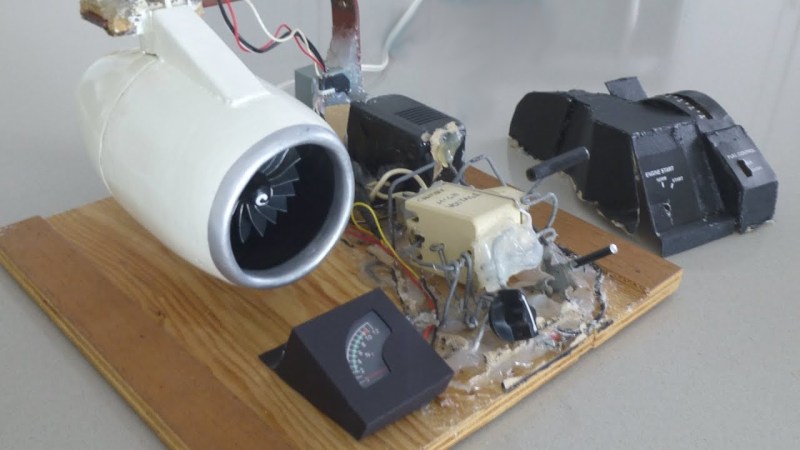[InterlinkKnight]’s jet engine model is a delight to behold and to puzzle out. Many of us have been there before. We know how to build something, we know it’s not the most up-to-date approach, but we just can’t help ourselves and so we go for it anyway. The result is often a fun and ingenious mix of the mechanical and the electrical. His electric jet engine model is just that.
Being a model, this one isn’t required to produce any useful thrust. But he’s made plenty of effort to make it behave as it should, right down to adding a piece of plastic to rub against a flywheel gear in order to produce the perfect high-pitched sound, not to forget the inclusion of the flywheel itself to make the turbine blades gradually slow down once the motor’s been turned off. For the N1 gauge (fan speed gauge) he built up his own generator around the motor shaft, sending the output through rectifying diodes to a voltmeter.
But the most delightful of all has to be the mechanical linkages for the controls. The controls consist of an Engine Start switch, Fuel Control switch and a throttle lever and are all built around a rheostat which controls the motor speed. The linkages are not pretty, but you have to admire his cleverness and just-go-for-it attitude. He must have done a lot of head scratching while getting it to all work together. We especially like how flipping the Fuel Control switch from cutoff to run levers the rheostat with respect to its dial just a little, to give a bit of extra power to the engine. See if you can puzzle it out in his Part 3 video below where he removes the cover and walks through it all.
Now if you’re looking for a working jet engine then check out this bike mounted one.
This one’s been around for a few months and we can’t believe it hasn’t been on Hackaday until now. Thanks for the tip [David].
















Hot glue gun explosion?
Looks more like they just melted a glue stick and stuck everything down.
First off, I wasn’t aware this site was dying. But anyway…
I’m of the opinion that for a rough hack, or something not meant to be looked at, then its appearance doesn’t matter. So if one wants to use, say, hot glue all over the place then that’s fine. But something resembling more of a model? Well, I guess beauty is in the eye of the beholder….
As for posting projects, not everyone has the desire to show off every single thing they do. Hard to believe in the Facebook era, I know. And if one can’t accept criticism, then best not expose yourself to it.
They did! And it’s glorious!
Looks about right in regards to plastic welding also. Is interesting how we can do the same for some outrageous costing headlight and even body components on vehicles now days in way more cost effective ways like a harbor freight kit. To look real expert… can think like lead, brazed or welded body panels for a level of achievement; where that material (say like using plastic as for plastic components) was used as filler by the best back in the day to be ground and sanded down with minimal, if any, bondo like filler material used before painting on painted parts. Interesting mechanical designs also. Glue guns are way neat and make fabrication super simple and quick. On a tangent, for some reason inspired with a new thought of usable duct fans for RC models can be made also with 3D printers now. Thanks for sharing and the inspiration. Neat project.
The sheer amount of glue ruins the illusion, but my god this is impressive. I always worry that if the world will end, there will be no one smart enough to rebuild it since everything relies on computers nowadays. So I’m glad there are people like you who can turn rocks into replicators as they say.
It is a mess but there is some great lateral thinking with the mechanical linkages and driving the dial.
This post isn’t about what he could have done had he known All The Things, it’s about that he accomplished something anyway and learned. The guy wasn’t afraid of what he didn’t know- he just dove in and BUILT it. and he LEARNED from it. A lot of us could do well to follow his example rather than criticize his building methods/materials. And for those that are criticizing the construction methods, you’ve completely missed the point.
Just because it isn’t pretty under the hood doesn’t mean it’s not really clever. The mechanical control interlocks are excellent.